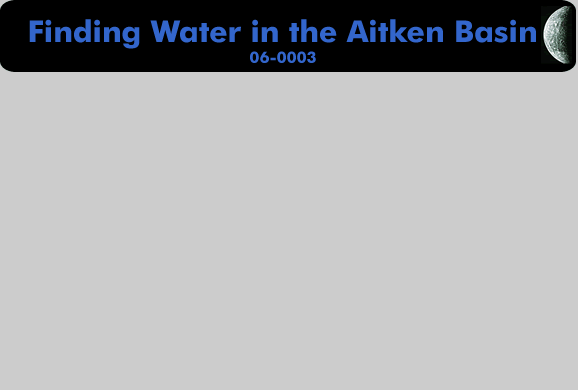Recommended Robot System
To address this project, we recommend a Robotic System that would incorporate existing technology. The system should have several backup features so that if one aspect failed to function as planned, the entire project could continue.
The Robotic System would be composed of four distinct features:
1) The Research Rover would be responsible for searching the Aitken Basin and testing samples to determine whether water exists. It would remain in the shadowed area of the Aitken Basin and would be equipped with an energy retrieval system to receive power from the Energy Stations, a navigation system to help it maneuver through the rough terrain of the Aitken Basin, tracking systems that plot the coordinates of each site tested, and moisture testing equipment that can confirm whether water was present.
2) The Energy Stations (three in all) would be responsible for collecting solar energy through and transmitting that energy to the Research Rover. These stations would be placed outside the Aitken Basin in areas that receive more consistent sunlight. They would also be used as part of the tracking system, since the coordinates of any area can be located when compared to three reference points.
3) The Backup Energy Transports would not be sent to the moon unless the Energy Transmission process failed. These transports would have the responsibility of traveling back and forth between the Energy Stations and the Research Rover to deliver power.
4) The Control Network would allow remote control of the other features and would uplink the information collected by the Research Rover to NASA. It would include existing satellite systems and the Navigation Network.
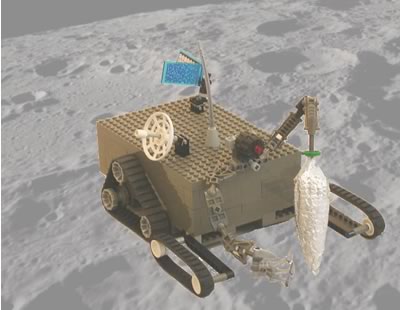
Our Research Rover would be box-like, as all rovers have been so far, to make it easier to transport and store. It would need to be made of titanium. Although aluminum has been used in previous successful lunar missions (Apollo missions 15-17) [23], it is a softer metal and may not withstand the landing or the extreme cold and hot temperatures. Titanium is more temperature resistant.
It would be semi-autonomous, meaning it would be partly controlled by remote and partly automatic. It would be able to move forward, stop, and turn. Our robot would have sensors on it to detect depth and to locate hydrogen. There would also be a camera to send NASA some idea of what was going on.
The robot would have treads, so separate wheels would not get stuck in small holes. There would also be two additional treads modeled after the PackBot EOD [24,25,26] that flip up or down to navigate tough terrain. It would have two arms, one with a drill and one with a grabbing claw for samples. Since the moon can be reached, unlike Mars, the robot would not need to land by itself. It would be sent via shuttle to a digging site. It would be set up by the astronauts that take it to the moon.
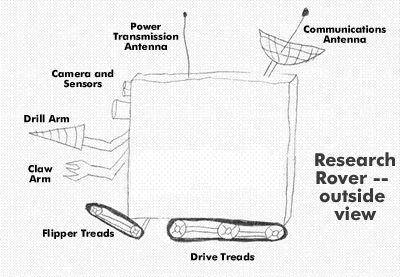
Based on research by Nikola Tesla, energy can be broadcast through airwaves [27,28]. This would be the fastest and easiest way to transfer power collected by the Energy Stations to the Research Rover. When it was in need of recharging, the Research Rover could communicate with each of the three Energy Stations to determine which one was closer to its present location. It would then send out a signal indicating that it was ready to receive the energy broadcast and recharge its lithium-ion batteries.
It would also have a direct hookup system that would upload energy from the Energy Transports, in case the Energy Transmission systems failed.
The Research Robot would need to have both manual and automatic navigation capabilities. It should be capable of remote control, much like the Lunakhod 1 which was driven by joystick with broadcast signal. The Lunokhod 1 drove 10,540 meters across the moon and lasted 11 months.
A robot that is completely remote control, however, is not practical and would have a greater risk of failure. Based on the distance of 385,000 kilometers from the earth to the moon [29] and the speed that light travels, 670,616,629.4 miles per hour, [30] the time differential between the earth and the moon is approximately one second. Although it seems short, a one second lag time does not provide sufficient respond time to overcome the obstacles on the moon’s surface. Plus, the visual feedback provided by the camera on the Research Rover would also be limited to the restrictions of transmitting video. Full motion video only provides 30 frames per second; transmitted signal would provide an even poorer signal than that. [31] ‘Robotic vision’ is not accurate because it is difficult to tell depth. It mainly tracks colors, which do not vary greatly on the moon’s surface.
To compensate for the poor quality of visual transmission available, other technology could be used. Since sound requires a medium to propagate through, sonar equipment would not work because there is not an atmosphere on the moon to reflect the sound of the sonar. [32] The Research Rover could, however, be equipped with Infrared Light Sensors. Infrared systems emit a light and read the strength of the reflected beam. This would allow the controller at NASA to determine depth.
The Research Rover would also include a Laser Range Finder. Laser Range Finders work much like the Infrared Sensors in that they send out laser beams and read the strength of the rebounded beam. They work more three dimensionally. They can be used to create a map of the surrounding surface area to avoid obstacles. [33]
Based on visual and tracking system data received, NASA could program the robot to make a series of moves. If the robot gets stuck, it would emit a signal indicating the problem.
Finally, to increase the chances of success, the Research Rover should be more autonomous than the MARS rover. It should have the capability to track its movements using Robot Odometry [34] by which the robot keeps track of where it goes so that it can reverse its actions to return to a site or back out of trouble. Although Odometry is less reliable due to errors caused by wheel slipping and obstacles, it would be a useful feature to help the Research Rover recover if it got stuck or came up to an unsurpassable obstacle.
The Energy Stations and the equipment used in the navigation system of the Research Rover could be used to track the movement of the Rover. Using the three Energy Stations as points of reference, a map could be plotted that tracked the movement of the Research Rover and a history of where it has drilled. Then, data provided by the Infrared System, the Laser Range Finders, and the Robot Odometry could be used to give three dimensional details to the map. Finally, a Global Positioning System could be set up as a backup tracking system.
Approximate location of the Energy Stations
relative to the Aitken Basin where the Research Rover would search for
water. |
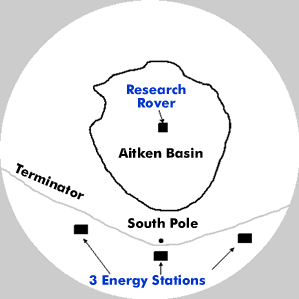 |
To investigate whether water was present, the Research Rover would have to drill deep below the moon’s surface and collect a sample. It could use a drill similar to the one on the MER robot. If water does exist, it would be in the form of ice because of the temperature in that area. The sample that the Research Rover collects would need to be heated. Humidity released from the heating process would be measured by a barometer to indicate the presence of moisture.
Sensors could also be calibrated to correspond to the expected changes in water. For instance, knowing that water turns to vapor around 212 °F degrees [35], the temperature at which moisture was detected could also be used to confirm whether water was present.
Once the sample was heated enough to form gas, an on-board Spectrometer could be used to further confirm whether the sample had the properties of water. Spectrometers pass light through a gas and read the resulting light spectrum. This is based on the principle that electrons for known substances absorb energy in a predictable wavelength. After the electrons are excited and then get unexcited, they emit energy in another wavelength. The spectrometer could measure whether the resulting spectrum matches that of water. [36]
Research Rover -- Inside layout of systems |
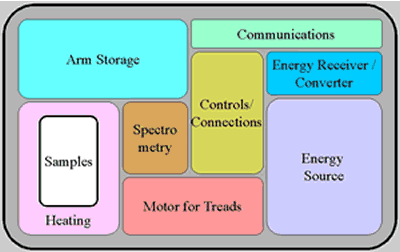 |
The Energy Station would need to be a compact design to make it easier to transport to the desired location. It would be delivered to the moon via traditional rocket technology and would have boosters that would allow it to navigate over the surface of the moon until the right landing spot was found. Once lowered into place, the outer covering of the Station would open and serve as the foundation of the Energy Station. There would need to be a rotating base of the Energy Station that would allow NASA to turn the solar panels toward direct sunlight to maximize the energy collected. Originally in a triangle design, the Station would then unfold, with the side panels extending out and the inside panels sliding up to provide twice the panel surface. After it extends, the panels can then be tilted to find the best angle to receive direct sunlight.
The Energy Station unfolds in six stages, as demonstrated below:
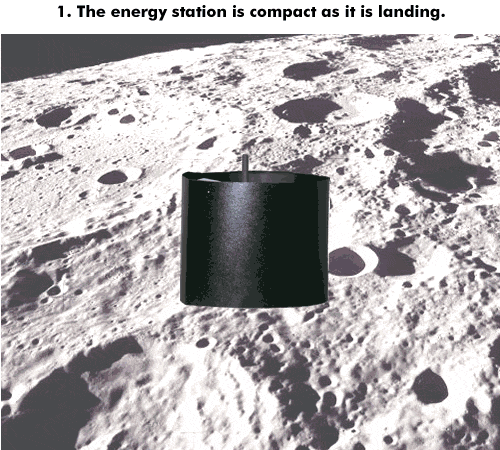
Except for the solar panels, most of the outer surface of the Energy Station would need to be made of titanium so it could withstand the extreme heat of the moon's surface when in the sunlight. Titanium can withstand 1668 °C, 3034 °F. [20] The inner working portion of the Station would need to be insulated and covered with a heat shield, much like the aeroshell of the MER robot, to protect the solar cells and transmitting system from the extreme heat. [9]
Solar panels on the Energy Stations would be used to collect energy from the sun. When the protons from sunlight hit the solar panel, some of the light gets absorbed in the semi conductor (like silicon). The light knocks some electrons (light) so that they can move freely creating a current. The current creates the electricity. [21] Solar cells sometimes last up to 30 years, but usually don't last anymore than five years. [22]
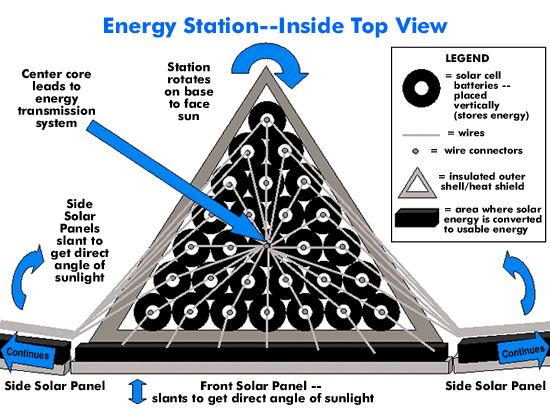
After the energy is collected and converted in the solar panels, it would be stored in solar cells located in the center of the Energy Station. These solar cells would have the capability to send the energy up to a transmitter when activated. When the Research Rover is in need of recharging, it could communicate with each of the three Energy Stations to determine which one is closest to its present location. It would then send out a signal indicating that it was ready to receive the energy broadcast and recharge its lithium-ion batteries. The Energy Station would also have a direct hookup option that would allow the Energy Transport to download the energy if the transmission system failed to work.
Backup Energy Transports could be sent up to the moon if the robot did not make it to the recharging stations in time. They would transport the energy from the recharging stations to the robot, then force open the panel to recharge the rover’s batteries. Then the transports would report to a recharging station to await their next calling.
To send signals to NASA, the rover would need to use the Deep Space Network. [37,38] This system of antennas would transfer its signals from the moon to the NASA base. Pictures, alarms, and updates would get to the base, so NASA always has some idea of what’s going on. |
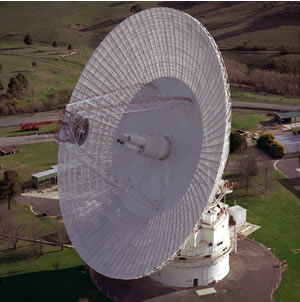 |


